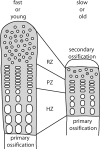Developmental and Evolutionary Allometry of the Mammalian Limb Skeleton
- PMID: 31180500
- PMCID: PMC6863755
- DOI: 10.1093/icb/icz082
Developmental and Evolutionary Allometry of the Mammalian Limb Skeleton
Abstract
The variety of limb skeletal proportions enables a remarkable diversity of behaviors that include powered flight in bats and flipper-propelled swimming in whales using extremes of a range of homologous limb architectures. Even within human limbs, bone lengths span more than an order of magnitude from the short finger and toe bones to the long arm and leg bones. Yet all of this diversity arises from embryonic skeletal elements that are each a very similar size at formation. In this review article, I survey what is and is not yet known of the development and evolution of skeletal proportion at multiple hierarchical levels of biological organization. These include the cellular parameters of skeletal elongation in the cartilage growth plate, genes associated with differential growth, and putative gene regulatory mechanisms that would allow both covariant and independent evolution of the forelimbs and hindlimbs and of individual limb segments. Although the genetic mechanisms that shape skeletal proportion are still largely unknown, and most of what is known is limited to mammals, it is becoming increasingly apparent that the diversity of bone lengths is an emergent property of a complex system that controls elongation of individual skeletal elements using a genetic toolkit shared by all.
© The Author(s) 2019. Published by Oxford University Press on behalf of the Society for Integrative and Comparative Biology. All rights reserved. For permissions please email: journals.permissions@oup.com.
Figures


Similar articles
-
Endochondral ossification and the evolution of limb proportions.Wiley Interdiscip Rev Dev Biol. 2020 Jul;9(4):e373. doi: 10.1002/wdev.373. Epub 2020 Jan 29. Wiley Interdiscip Rev Dev Biol. 2020. PMID: 31997553 Review.
-
Forelimb versus hindlimb skeletal development in the big brown bat, Eptesicus fuscus: functional divergence is reflected in chondrocytic performance in Autopodial growth plates.Cells Tissues Organs. 2008;187(1):35-47. doi: 10.1159/000109962. Epub 2007 Dec 11. Cells Tissues Organs. 2008. PMID: 18160801
-
Evolutionary and developmental aspects of avian-specific traits in limb skeletal pattern.Zoolog Sci. 2012 Oct;29(10):631-44. doi: 10.2108/zsj.29.631. Zoolog Sci. 2012. PMID: 23030336 Review.
-
Limbs in whales and limblessness in other vertebrates: mechanisms of evolutionary and developmental transformation and loss.Evol Dev. 2002 Nov-Dec;4(6):445-58. doi: 10.1046/j.1525-142x.2002.02033.x. Evol Dev. 2002. PMID: 12492145
-
Precocial hindlimbs and altricial forelimbs: partitioning ontogenetic strategies in mallards (Anas platyrhynchos).J Exp Biol. 2012 Nov 1;215(Pt 21):3703-10. doi: 10.1242/jeb.057380. Epub 2012 Aug 1. J Exp Biol. 2012. PMID: 22855613
Cited by
-
Humerus shape evolved in cetaceans under relaxed selection and random drift.Commun Biol. 2025 Mar 29;8(1):518. doi: 10.1038/s42003-025-07952-w. Commun Biol. 2025. PMID: 40158047 Free PMC article.
-
Cellular and molecular mechanisms that shape the development and evolution of tail vertebral proportion in mice and jerboas.bioRxiv [Preprint]. 2024 Oct 26:2024.10.25.620311. doi: 10.1101/2024.10.25.620311. bioRxiv. 2024. PMID: 39484405 Free PMC article. Preprint.
-
Application of 3D MAPs pipeline identifies the morphological sequence chondrocytes undergo and the regulatory role of GDF5 in this process.Nat Commun. 2021 Sep 10;12(1):5363. doi: 10.1038/s41467-021-25714-0. Nat Commun. 2021. PMID: 34508093 Free PMC article.
-
Compensatory growth and recovery of cartilage cytoarchitecture after transient cell death in fetal mouse limbs.Nat Commun. 2024 Apr 5;15(1):2940. doi: 10.1038/s41467-024-47311-7. Nat Commun. 2024. PMID: 38580631 Free PMC article.
-
Individual Cryptic Scaling Relationships and the Evolution of Animal Form.Integr Comp Biol. 2019 Nov 1;59(5):1411-1428. doi: 10.1093/icb/icz135. Integr Comp Biol. 2019. PMID: 31364716 Free PMC article. Review.
References
-
- Adams RA. 2008. Morphogenesis in bat wings: linking development, evolution and ecology. Cells Tissues Organs 187:13–23. - PubMed
-
- Baron J, Klein KO, Colli MJ, Yanovski JA, Novosad JA, Bacher JD, Cutler GB.. 1994. Catch-up growth after glucocorticoid excess: a mechanism intrinsic to the growth plate. Endocrinology 135:1367–71. - PubMed
-
- Barreto C, Wilsman NJ.. 1994. Hypertrophic chondrocyte volume and growth rates in avian growth plates. Res Vet Sci 56:53–61. - PubMed
-
- Bell E, Andres B, Goswami A.. 2011. Integration and dissociation of limb elements in flying vertebrates: a comparison of pterosaurs, birds and bats. J Evol Biol 24:2586–99. - PubMed
-
- Biewener AA. 1990. Biomechanics of mammalian terrestrial locomotion. Science 250:1097–103. - PubMed
Publication types
MeSH terms
Grants and funding
LinkOut - more resources
Full Text Sources

